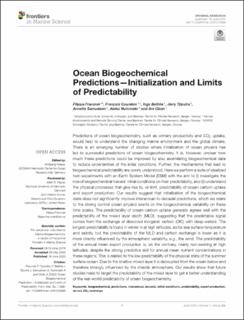| dc.contributor.author | Fransner, Filippa | |
| dc.contributor.author | Counillon, Francois | |
| dc.contributor.author | Bethke, Ingo | |
| dc.contributor.author | Tjiputra, Jerry | |
| dc.contributor.author | Samuelsen, Annette | |
| dc.contributor.author | Nummelin, Aleksi | |
| dc.contributor.author | Olsen, Are | |
| dc.date.accessioned | 2021-02-12T09:40:16Z | |
| dc.date.available | 2021-02-12T09:40:16Z | |
| dc.date.created | 2020-08-26T22:53:55Z | |
| dc.date.issued | 2020 | |
| dc.identifier.issn | 2296-7745 | |
| dc.identifier.uri | https://hdl.handle.net/11250/2727635 | |
| dc.description.abstract | Predictions of ocean biogeochemistry, such as primary productivity and CO2 uptake, would help to understand the changing marine environment and the global climate. There is an emerging number of studies where initialization of ocean physics has led to successful predictions of ocean biogeochemistry. It is, however, unclear how much these predictions could be improved by also assimilating biogeochemical data to reduce uncertainties of the initial conditions. Further, the mechanisms that lead to biogeochemical predictability are poorly understood. Here we perform a suite of idealized twin experiments with an Earth System Model (ESM) with the aim to (i) investigate the role of biogeochemical tracers' initial conditions on their predictability, and (ii) understand the physical processes that give rise to, or limit, predictability of ocean carbon uptake and export production. Our results suggest that initialization of the biogeochemical state does not significantly improve interannual-to-decadal predictions, which we relate to the strong control ocean physics exerts on the biogeochemical variability on these time scales. The predictability of ocean carbon uptake generally agrees well with the predictability of the mixed layer depth (MLD), suggesting that the predictable signal comes from the exchange of dissolved inorganic carbon (DIC) with deep-waters. The longest predictability is found in winter in at high latitudes, as for sea surface temperature and salinity, but the predictability of the MLD and carbon exchange is lower as it is more directly influenced by the atmospheric variability, e.g., the wind. The predictability of the annual mean export production is, on the contrary, nearly non-existing at high latitudes, despite the strong predictive skill for annual mean nutrient concentrations in these regions. This is related to the low predictability of the physical state of the summer surface ocean. Due to the shallow mixed layer it is decoupled from the ocean below and therefore strongly influenced by the chaotic atmosphere. Our results show that future studies need to target the predictability of the mixed layer to get a better understanding of the real-world predictability of ocean biogeochemistry. | en_US |
| dc.language.iso | eng | en_US |
| dc.publisher | Frontiers | en_US |
| dc.rights | Navngivelse 4.0 Internasjonal | * |
| dc.rights.uri | http://creativecommons.org/licenses/by/4.0/deed.no | * |
| dc.title | Ocean Biogeochemical Predictions—Initialization and Limits of Predictability | en_US |
| dc.type | Journal article | en_US |
| dc.type | Peer reviewed | en_US |
| dc.description.version | published version | en_US |
| dc.rights.holder | Copyright © 2020 Fransner, Counillon, Bethke, Tjiputra, Samuelsen, Nummelin and Olsen. | en_US |
| cristin.ispublished | true | |
| cristin.fulltext | original | |
| cristin.qualitycode | 1 | |
| dc.identifier.doi | 10.3389/fmars.2020.00386 | |
| dc.identifier.cristin | 1825403 | |
| dc.source.journal | Frontiers in Marine Science | en_US |
| dc.source.40 | 7 | en_US |
| dc.source.14 | 386 | en_US |
| dc.relation.project | Notur/NorStore: NN1002K | en_US |
| dc.relation.project | Notur/NorStore: NS1002K | en_US |
| dc.relation.project | Notur/NorStore: NS9039K | en_US |
| dc.relation.project | Norges forskningsråd: 275268 | en_US |
| dc.relation.project | Notur/NorStore: NN9039K | en_US |
| dc.relation.project | Norges forskningsråd: 276730 | en_US |

